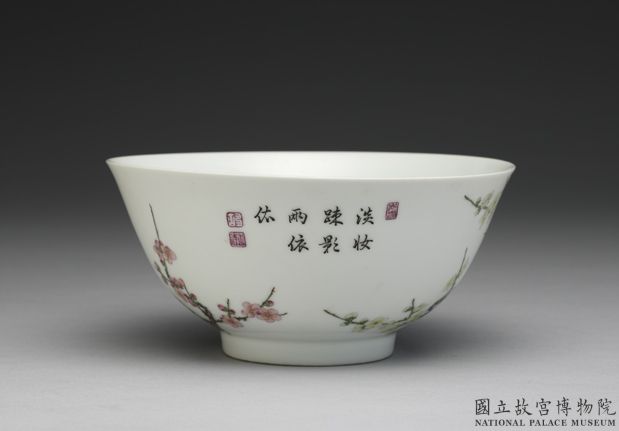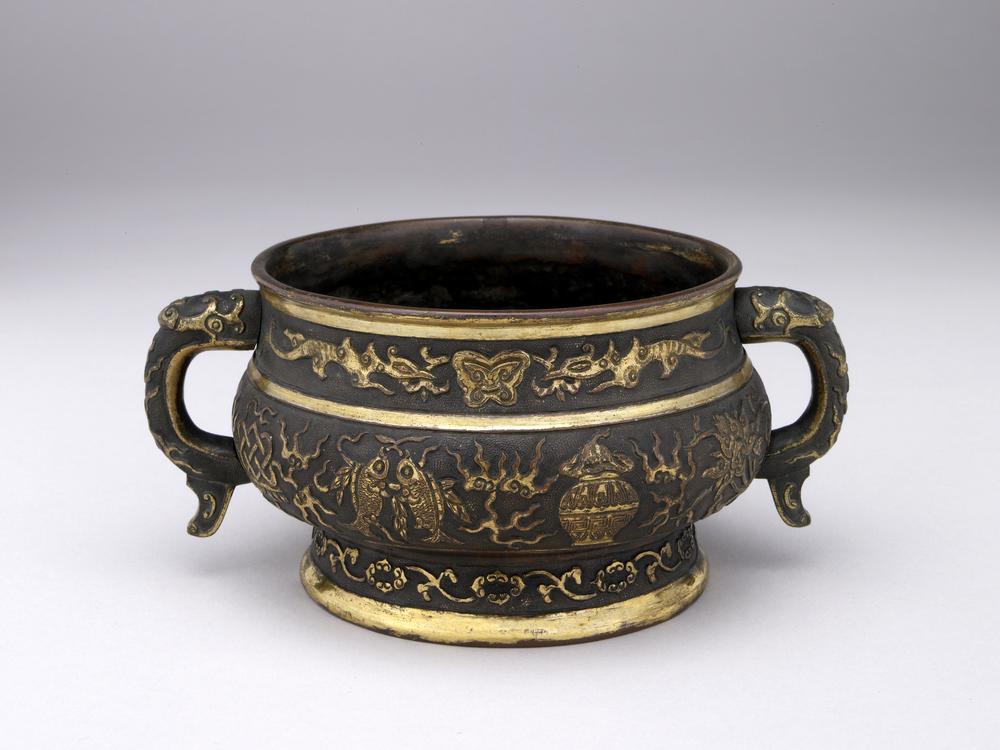Period:Ming dynasty Production date:1522-1620 (circa)
Materials:porcelain
Technique:celadon-glazed, applied, moulded, impressed,
Subjects:dragon
Dimensions:Diameter: 6 centimetres Height: 19.50 centimetres
Description:
Porcelain bottle in the form of an ancient jade ‘cong’. This bottle is made in triangular cross-section, each of the corners cut off to form six vertical faces. It has a peach-shaped neck and squared shoulders and stands on a rectangular base. The sides are decorated in applied moulded relief with two ‘chi’ dragons in complementary positions surrounded by five discs with square centres representing cash coins; with two ‘chi’ dragons; with an impressed lattice design bordered by key-fret; with circular ornament.
IMG
![图片[1]-flower-vase(cong) BM-1973-0726.334-China Archive](https://chinaarchive.net/Ming dynasty/Ceramics/mid_00273114_001.jpg)
Comments:Harrison-Hall 2001:The peach symbolizes longevity and the coins financial success.The ‘cong’, a rectangular slab made of jade surrounding a central tube, was produced during the Neolithic period in China. It was remodelled in the later dynasties in ceramic: for example, a ‘guan’ ware vase in the shape of a cong made in the Southern Song dynasty is in the Tokyo National Museum. A Yuan example with an integral stand is in the Itsuo Bijitsukan, Japan. Although it is unlikely that the present vessel is precisely copying a Ming archaistic jade cong, it does have much in common with a cylindrical archaistic jade vessel with dragons in relief along the sides lent anonymously to the ‘Chinese Jade Throughout the Ages’ exhibition held at the Victoria and Albert Museum, London, in 1975. Relief dragons are a decorative feature of several of the jades included in the Han period tombs of the king of Nanyue. The present ceramic vessel may be regarded as combining a variety of different ancient and contemporary Ming jade styles.This type of crackled green glaze and relief-moulded decoration is a feature of late Ming ceramics from the Longquan kilns. A vase with raised figural decoration and snake-like dragons is in the Longquan Qingci Museum. Possibly made at JIngdezhen for the Japanese market in the late Ming period.
Materials:porcelain
Technique:celadon-glazed, applied, moulded, impressed,
Subjects:dragon
Dimensions:Diameter: 6 centimetres Height: 19.50 centimetres
Description:
Porcelain bottle in the form of an ancient jade ‘cong’. This bottle is made in triangular cross-section, each of the corners cut off to form six vertical faces. It has a peach-shaped neck and squared shoulders and stands on a rectangular base. The sides are decorated in applied moulded relief with two ‘chi’ dragons in complementary positions surrounded by five discs with square centres representing cash coins; with two ‘chi’ dragons; with an impressed lattice design bordered by key-fret; with circular ornament.
IMG
![图片[1]-flower-vase(cong) BM-1973-0726.334-China Archive](https://chinaarchive.net/Ming dynasty/Ceramics/mid_00273114_001.jpg)
Comments:Harrison-Hall 2001:The peach symbolizes longevity and the coins financial success.The ‘cong’, a rectangular slab made of jade surrounding a central tube, was produced during the Neolithic period in China. It was remodelled in the later dynasties in ceramic: for example, a ‘guan’ ware vase in the shape of a cong made in the Southern Song dynasty is in the Tokyo National Museum. A Yuan example with an integral stand is in the Itsuo Bijitsukan, Japan. Although it is unlikely that the present vessel is precisely copying a Ming archaistic jade cong, it does have much in common with a cylindrical archaistic jade vessel with dragons in relief along the sides lent anonymously to the ‘Chinese Jade Throughout the Ages’ exhibition held at the Victoria and Albert Museum, London, in 1975. Relief dragons are a decorative feature of several of the jades included in the Han period tombs of the king of Nanyue. The present ceramic vessel may be regarded as combining a variety of different ancient and contemporary Ming jade styles.This type of crackled green glaze and relief-moulded decoration is a feature of late Ming ceramics from the Longquan kilns. A vase with raised figural decoration and snake-like dragons is in the Longquan Qingci Museum. Possibly made at JIngdezhen for the Japanese market in the late Ming period.
© Copyright
The copyright of the article belongs to the author, please keep the original link for reprinting.
THE END





